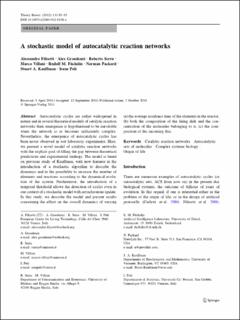Please use this identifier to cite or link to this item:
https://doi.org/10.21256/zhaw-4098Full metadata record
| DC Field | Value | Language |
|---|---|---|
| dc.contributor.author | Filisetti, Alessandro | - |
| dc.contributor.author | Graudenzi, Alex | - |
| dc.contributor.author | Serra, Roberto | - |
| dc.contributor.author | Villani, Marco | - |
| dc.contributor.author | Füchslin, Rudolf Marcel | - |
| dc.contributor.author | Packard, Norman | - |
| dc.contributor.author | Kauffman, Stuart A. | - |
| dc.contributor.author | Poli, Irene | - |
| dc.date.accessioned | 2018-02-09T14:47:06Z | - |
| dc.date.available | 2018-02-09T14:47:06Z | - |
| dc.date.issued | 2012 | - |
| dc.identifier.issn | 1611-7530 | de_CH |
| dc.identifier.issn | 1431-7613 | de_CH |
| dc.identifier.uri | https://digitalcollection.zhaw.ch/handle/11475/2721 | - |
| dc.description | Erworben im Rahmen der Schweizer Nationallizenzen (http://www.nationallizenzen.ch) | de_CH |
| dc.description.abstract | Autocatalytic cycles are rather widespread in nature and in several theoretical models of catalytic reaction networks their emergence is hypothesized to be inevitable when the network is or becomes sufficiently complex. Nevertheless, the emergence of autocatalytic cycles has been never observed in wet laboratory experiments. Here, we present a novel model of catalytic reaction networks with the explicit goal of filling the gap between theoretical predictions and experimental findings. The model is based on previous study of Kauffman, with new features in the introduction of a stochastic algorithm to describe the dynamics and in the possibility to increase the number of elements and reactions according to the dynamical evolution of the system. Furthermore, the introduction of a temporal threshold allows the detection of cycles even in our context of a stochastic model with asynchronous update. In this study, we describe the model and present results concerning the effect on the overall dynamics of varying (a) the average residence time of the elements in the reactor, (b) both the composition of the firing disk and the concentration of the molecules belonging to it, (c) the composition of the incoming flux. | de_CH |
| dc.language.iso | en | de_CH |
| dc.publisher | Springer | de_CH |
| dc.relation.ispartof | Theory in Biosciences | de_CH |
| dc.rights | Licence according to publishing contract | de_CH |
| dc.subject | Catalytic reaction networks | de_CH |
| dc.subject | Autocatalytic sets of molecules | de_CH |
| dc.subject | Complex systems biology | de_CH |
| dc.subject | Origin of life | de_CH |
| dc.subject.ddc | 540: Chemie | de_CH |
| dc.subject.ddc | 570: Biologie | de_CH |
| dc.title | A stochastic model of autocatalytic reaction networks | de_CH |
| dc.type | Beitrag in wissenschaftlicher Zeitschrift | de_CH |
| dcterms.type | Text | de_CH |
| zhaw.departement | School of Engineering | de_CH |
| zhaw.organisationalunit | Institut für Angewandte Mathematik und Physik (IAMP) | de_CH |
| dc.identifier.doi | 10.21256/zhaw-4098 | - |
| dc.identifier.doi | 10.1007/s12064-011-0136-x | de_CH |
| zhaw.funding.eu | No | de_CH |
| zhaw.issue | 2 | de_CH |
| zhaw.originated.zhaw | Yes | de_CH |
| zhaw.pages.end | 93 | de_CH |
| zhaw.pages.start | 85 | de_CH |
| zhaw.publication.status | publishedVersion | de_CH |
| zhaw.volume | 131 | de_CH |
| zhaw.embargo.end | 2018-01-01 | de_CH |
| zhaw.publication.review | Peer review (Publikation) | de_CH |
| Appears in collections: | Publikationen School of Engineering | |
Files in This Item:
| File | Description | Size | Format | |
|---|---|---|---|---|
| 2012_Filisetti_A stochastic model of autocatalytic reaction networks_Theory in Biosciences.pdf | Zugriff erlaubt ab dem 1.1.2017 | 473.54 kB | Adobe PDF |  View/Open |
Show simple item record
Filisetti, A., Graudenzi, A., Serra, R., Villani, M., Füchslin, R. M., Packard, N., Kauffman, S. A., & Poli, I. (2012). A stochastic model of autocatalytic reaction networks. Theory in Biosciences, 131(2), 85–93. https://doi.org/10.21256/zhaw-4098
Filisetti, A. et al. (2012) ‘A stochastic model of autocatalytic reaction networks’, Theory in Biosciences, 131(2), pp. 85–93. Available at: https://doi.org/10.21256/zhaw-4098.
A. Filisetti et al., “A stochastic model of autocatalytic reaction networks,” Theory in Biosciences, vol. 131, no. 2, pp. 85–93, 2012, doi: 10.21256/zhaw-4098.
FILISETTI, Alessandro, Alex GRAUDENZI, Roberto SERRA, Marco VILLANI, Rudolf Marcel FÜCHSLIN, Norman PACKARD, Stuart A. KAUFFMAN und Irene POLI, 2012. A stochastic model of autocatalytic reaction networks. Theory in Biosciences. 2012. Bd. 131, Nr. 2, S. 85–93. DOI 10.21256/zhaw-4098
Filisetti, Alessandro, Alex Graudenzi, Roberto Serra, Marco Villani, Rudolf Marcel Füchslin, Norman Packard, Stuart A. Kauffman, and Irene Poli. 2012. “A Stochastic Model of Autocatalytic Reaction Networks.” Theory in Biosciences 131 (2): 85–93. https://doi.org/10.21256/zhaw-4098.
Filisetti, Alessandro, et al. “A Stochastic Model of Autocatalytic Reaction Networks.” Theory in Biosciences, vol. 131, no. 2, 2012, pp. 85–93, https://doi.org/10.21256/zhaw-4098.
Items in DSpace are protected by copyright, with all rights reserved, unless otherwise indicated.